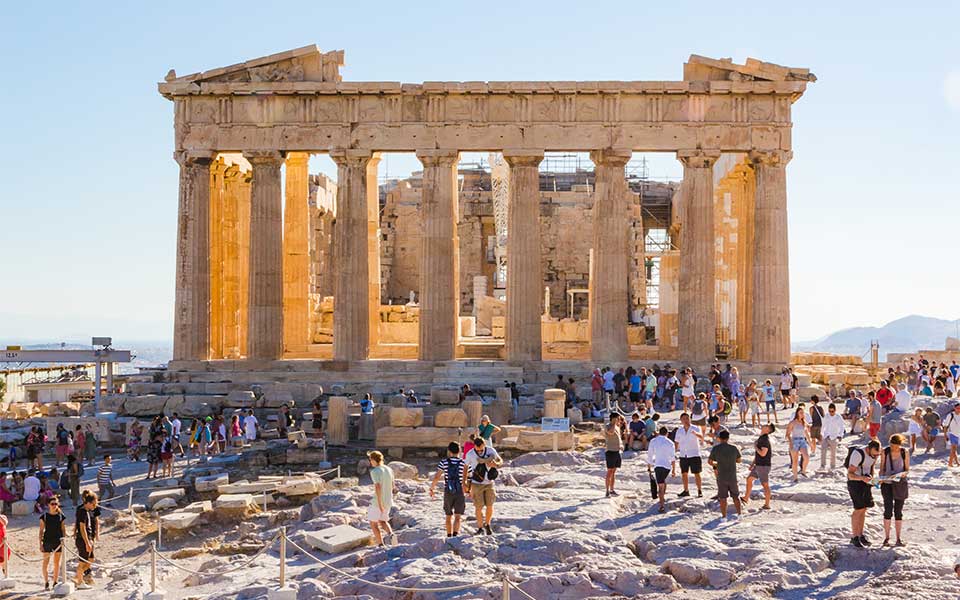By Nikolas Zois
On Monday 4th of September, the Acropolis introduced the new ticketing system that had been announced earlier by the Ministry of Culture. The new system, which is currently being implemented on a pilot basis, was launched with much shorter queues compared to those visitors had to endure in July and August when the Acropolis received an average of 23,000 persons per day, with tourists showing an open-mindedness and a willingness to cooperate – albeit expressing concerns regarding the level of communication and information – and under slightly better weather conditions and with fewer visitors than the week before.
For the first two days of its implementation, the measure will not apply to organized tour groups that have purchased their tickets in advance – the new measure will apply to organized tour groups from Wednesday. Individual tourists, however, were surprised to see that from yesterday (specifically Sunday evening when the official e-ticket platform was launched) they’re required to choose the exact time they want to visit the Acropolis. This is because the new ticketing system imposes a daily limit on the number of persons who can visit the Acropolis at 20,000, each timeslot having a limited number of tickets (the morning timeslots that are considered peak visiting hours will receive the largest number of visitors, such as the 08:00-09:00 timeslot that will “accommodate” 3,000 persons). The new measure will not only help alleviate the problem of the hordes of people who visit the “Sacred Rock” en masse, but also protect the monument.
Indicatively, yesterday, just a little before 9:30, at the entrance that is located on the southeastern side of the Acropolis, we met Charles and Arian from Canada who, with the help of the monument’s staff, had just used one of the recently installed ticket-vending machines and bought a ticket for 10:00-11:00 which was the first available timeslot. “Thirty minutes is definitely better than waiting two hours for such a historic monument”, Arian told “K” and continued “If you have your ticket and you know when you’re going to enter, it’s easier to organize your day and plan your visit”. A few minutes later, 30-year-old Tan from Singapore and his partner, who had been waiting in line to buy their tickets from 10:00, weren’t as lucky. “Unfortunately, we couldn’t find a ticket for 12:00”, Tan noted regrettably.
At the main entrance of the Acropolis, the queues were slightly longer. Many of the large organized tour groups had come early in the morning and had already left as most visitors were waiting in line at the ticket counters. That’s where they heard, with some frustration, about the new ticketing system. Like 35-year-old Aiguin from Turkey who a little before 10:30 found a ticket for 12:00. “I would have preferred to visit the Acropolis straight away without having to wait, but I understand why they’re doing this”, she said. However, 60-year-old Lynn and 41-year-old Jemma from England didn’t seem to share her opinion. They had bought a ticket for the 12:00-13:00 timeslot and were waiting patiently in the shade. They were hoping to visit the Acropolis earlier to avoid the heat, but they had only learnt of the new system when they arrived at the ticket counters. “We understand why they’re implementing the measure”, they said, “but there isn’t a lot of information, like a sign or a map that could inform and direct visitors. Also, the staff aren’t particularly helpful.”
Sixty-year-old Frank from Melbourne, Australia, was sitting on a bench with his partner. They also had a ticket for 12:00 which they had bought at 10:00. “The measure isn’t very practical”, he remarked. “It makes sense because the antiquities need to be protected. But I think they could do better in terms of informing the public”, he said and referred to the major sports events his country organizes where people are informed well in advance and know exactly where they will be sitting.
“Perhaps it would be better if there was a screen or a board that could inform visitors of the timeslots and the number of tickets that are available”, noted 37-year-old Alessandra from Italy. She had been waiting in line for 30 minutes when she found a ticket for 13:00, but she was afraid that she wouldn’t make her flight on time. Jacob and Michelle from Germany were a bit more optimistic. They were lucky enough to find a ticket for 12:00. “It seems to be a good measure, because things will be more structured”, remarked Jacob who continued “I just hope that they won’t be letting people in haphazardly during peak days and hours.”
The peak days and hours will be back next summer, at which time –from April 2024 – the new measure will have passed from its pilot phase to its full implementation. The measure was based on a study that was carried out by the Hellenic Organization of Cultural Resources Development which had organized a number of meetings with professionals of Greece’s tourism sector in order to get their opinions. In fact, the Hellenic Organization of Cultural Resources Development and the Ministry of Culture are considering expanding the measure to other archaeological sites and monuments in Greece where electronic tickets are issued.












